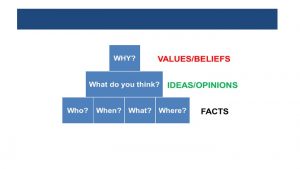
Does your teaching style engage, energize, and empower your students?
I conduct seminars, workshops, and teach college classes on leadership.
I use three teaching styles—Directing, Discussing, and Delegating.
I generally structure my classes to include using some amount of each style. However, during the first part of the semester, I primarily use the directing style. In the middle part of a semester, I more frequently use a discussing style. And, at the end of the semester, I assign team projects so rely more heavily on the delegating style.
The Directing Style
The teacher describes his or her general expectations, as well as the rules and procedures that students need to follow. On specific assignments, the teacher tells the students what to do, how to do it, and when to have it done.
The directing style promotes learning through listening and following directions.
- Communication is predominantly one-way, from teacher to student. The teacher needs to be clear, concise, and complete. Students gain information primarily by listening, taking notes, and receiving written instructions. The only feedback the teacher looks for is “Do you understand the directions?”
- Coaching occurs as the teacher tells students what changes are needed. In addition, the teacher may demonstrate the desired behavior, such as rewriting a passage to improve clarity or conducting a role-play to illustrate a better approach.
- Recognition—the teacher praises students who follow directions and correctly answer questions.
Tips for using the directing style
- Make sure you have the student’s attention. All eyes are on me. You need to pay close attention to these instructions.
- Provide the context before launching into the details.
- If needed, put the directions in writing so students can refer back to them.
- Don’t sugar-coat the message. There are times when teachers need to be very direct and candid to get through to students.
What can you do to improve your directions?
The Discussing Style
The teacher asks questions that require students to think and respond. The diagram below lists the common types of questions that teachers ask.

The discussing style promotes learning by having students recall facts, analyze problems, brainstorm ideas, offer opinions, debate options, make decisions, and provide evidence for their position.
- Communication is two-way (between teacher and student) or multi-way (among students and teacher). The teacher asks follow-up questions to that require students to identify underlying assumptions, beliefs, feelings, values, and reasoning.
- Coaching occurs when the teacher asks questions that require students to evaluate their own performance. Some good questions include “How do you think you did? What could you have done better? What steps can you take to improve?” The goal is to encourage students to analyze their performance and identify what they can do to improve.
- Recognition—the teacher praises students who express their ideas clearly and succinctly. In addition, students are praised for building on the ideas of others and assisting the group reaches logical conclusions.
Tips for using the discussing style
- Prepare questions in advance. Great discussions don’t just happen.
- Ask one question at a time.
- Don’t allow one or two students to dominate the discussion. Solicit everyone’s ideas and opinions.
- Require students to create their own questions on assigned topics.
What can you do to improve your group discussions and one-on-one discussions?
The Delegating Style
The teacher empowers the students to work independently, either individually or in teams.
The delegating style promotes learning through action. Students learn by doing. On their own, they set goals, develop plans, solve problems, and learn to manage their time. When working on team projects, they learn to collaborate, communicate, listen, run meetings, and influence team members.
- Communication occurs as the teacher assigns projects. Students ask questions until they fully understand what needs to be accomplished and when it’s due. However, the teacher doesn’t tell the students how to get the task done, that’s left up to the students.
- Coaching is accomplished primarily through self-coaching. Students critique their own performance. For example, I might say this to a student: “I want you to think about your performance on this assignment. Identify three things you did well and one area needing improvement. I’d like to meet tomorrow at 10:00 a.m. to hear what you come up with.”
- Recognition—the teacher praises the students who take initiative, solve problems, work well in a team setting, produce quality work, and meet deadlines.
Tips for using the delegating style
- Make sure students are clear regarding the desired end product.
- Always provide a due date.
- For major assignments and capstone projects require interim status updates to evaluate progress.
- Turn performance issues into learning opportunities.
What can you do to improve the way you delegate tasks?
Use a teaching style that fits the needs of the situation.
It is important for teachers to monitor each student’s performance. Some students may require more structure than others, so a directing style is appropriate. Other students will demonstrate their ability to work independently, so a delegating style works best. The key is to be adaptable and flexible. Change your style as students become more capable and confident.
Summary
There is no one best teaching style. Each one is effective in certain situations. Effective teachers are adaptable and flexible. They use a teaching style that works best in helping students learn, grow, and achieve their potential. Here is the sign I kept in my office.




